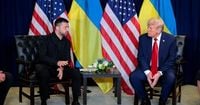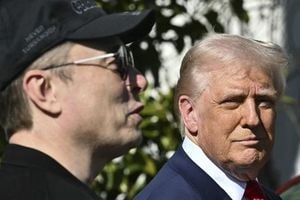In a dramatic and unexpected turn on the world stage, President Donald Trump reversed his longstanding position on the war in Ukraine, declaring that Ukraine could win back all its seized land from Russia—a move that has sent ripples through international diplomatic circles and left both allies and adversaries scrambling to interpret the implications.
The shift, announced on September 23, 2025, came after months in which Trump had repeatedly suggested that Kyiv would likely need to cede territory to Russia to end the conflict. Suddenly, after a high-profile meeting with Ukrainian President Volodymyr Zelenskyy at the United Nations in New York, Trump proclaimed, “After getting to know and fully understand the Ukraine/Russia Military and Economic situation and, after seeing the Economic trouble it is causing Russia, I think Ukraine, with the support of the European Union, is in a position to fight and WIN all of Ukraine back in its original form.” He added, “With time, patience, and the financial support of Europe and, in particular, NATO, the original Borders from where this War started, is very much an option. Why not?”
Trump’s new assessment didn’t stop there. He openly questioned Russia’s military prowess, calling Moscow a “paper tiger” and casting doubt on its status as a real military power. This was a sharp departure from his previous alignment with the Kremlin’s narrative and his repeated assertions that Ukraine would have to accept territorial losses for peace. As reported by NBC News, this reversal stunned traditional U.S. allies in Europe. Ukrainian President Zelenskyy described it as “a big shift,” adding that he saw it as “very positive.”
Not everyone was convinced that Trump’s latest declaration signaled a permanent change. William Taylor, former U.S. ambassador to Ukraine, told ABC News, “Diplomacy likes consistency, of course. Everybody does. But rather than U-turns or flip-flops, I would say this is an acceleration of a trend. There is a trend over the past, say, two months, three months of Trump being irritated with, frustrated with, even pissed off with, Putin.” Taylor continued, “And by the same token, that three-month period has been up and down a bit, but more cordial, more supportive, more interested in, more admiring of the Europeans, of the Ukrainians, including Zelenskyy. So, I think this is a trend, it’s not a smooth trend, but it’s in the direction of more support for Ukraine and frustration and anger with Putin.”
The very next day, on September 24, 2025, U.S. Secretary of State Marco Rubio met with Russian Foreign Minister Sergei Lavrov on the sidelines of the United Nations General Assembly in New York. The meeting, which lasted about 50 minutes, was attended by U.S. Ambassador to the United Nations Mike Waltz and their respective delegations. As Lavrov left the meeting, he declined to answer questions about Trump’s shift or whether the U.S. president had turned his back on Russia. Rubio’s office released a brief statement, saying only that he “reiterated President Trump’s call for the killing to stop and the need for Moscow to take meaningful steps toward a durable resolution of the Russia-Ukraine war.”
Russian officials were quick to push back against Trump’s new rhetoric. Kremlin spokesperson Dmitry Peskov rejected the “paper tiger” characterization, insisting that Russia was “a bear” and that Trump was mistaken. “Trump heard Zelenskyy’s version of events. Apparently, this version was the reason for the assessment we heard. We cannot agree with everything here,” Peskov stated, as reported by ABC News. He added that Lavrov’s meeting with Rubio would be an opportunity to convey Moscow’s perspective directly to the American side.
Meanwhile, President Zelenskyy seized the moment to address the United Nations General Assembly, warning that Russian President Vladimir Putin intended to expand the war and that the international order was at risk. “International law doesn’t work fully unless you have powerful friends who are truly willing to stand up for it,” Zelenskyy told the assembly. “And even that doesn’t work without weapons. It’s terrible but without it, things will be even worse. There are no security guarantees except friends and weapons.” He urged immediate action, stating, “If it takes pressure on Russia, it must be done and it must be done now otherwise Putin will keep driving the war forward, wider and deeper. We told you before, Ukraine is only the first and now Russian drones are already flying across Europe, and Russian operations are already spreading across countries ... No one can feel safe right now.”
Trump’s statement also included a suggestion that NATO countries should shoot down Russian aircraft if they enter their airspace, a proposal that raised eyebrows among both allies and critics. Vice President JD Vance, speaking on September 24, 2025, insisted that Trump’s comments were “not a shift in position,” but rather a response to the evolving “reality on the ground.” Vance elaborated, “One of the things I’ll say about the president is that he is responsive to the reality on the ground, and the reality on the ground is that number one, we have engaged in incredibly good faith negotiations with both the Russians and the Ukrainians, and I believe the president is growing incredibly impatient with the Russians right now because he doesn’t feel like they’re putting enough on the table to end the war. That’s number one.” He echoed Trump’s message that Russia’s economic and battlefield situation is grim after years of conflict.
Despite the apparent shift, some observers remain skeptical about Trump’s consistency. As NBC News highlighted, the president has a history of abrupt reversals: promising a quick end to the war, pledging new sanctions on Russia, insisting on a ceasefire before negotiations, and repeatedly changing his stance on whether Ukraine must cede territory. In the days leading up to his latest statement, Trump had downplayed the war’s relevance to the United States, saying during a U.K. press conference, “It doesn’t affect the United States,” and later telling Fox News, “It doesn’t affect us because, like, we have a big ocean in between.”
Some analysts interpret Trump’s new declaration as less a commitment to Ukraine’s cause and more a desire to disengage from the conflict altogether. As noted by NBC News, “It seems far more accurate to say Trump was signaling his eagerness to walk away altogether, leaving the future of the war in others’ hands.” Trump himself concluded his statement with, “In any event, I wish both Countries well. We will continue to supply weapons to NATO for NATO to do what they want with them. Good luck to all!”
As the world digests Trump’s latest pivot, questions remain about what—if any—policy changes will follow, and whether the president’s words will translate into sustained support for Ukraine or simply mark another chapter in a pattern of shifting rhetoric. For now, the only certainty is that the war’s future, and America’s role in it, remains as unpredictable as ever.




